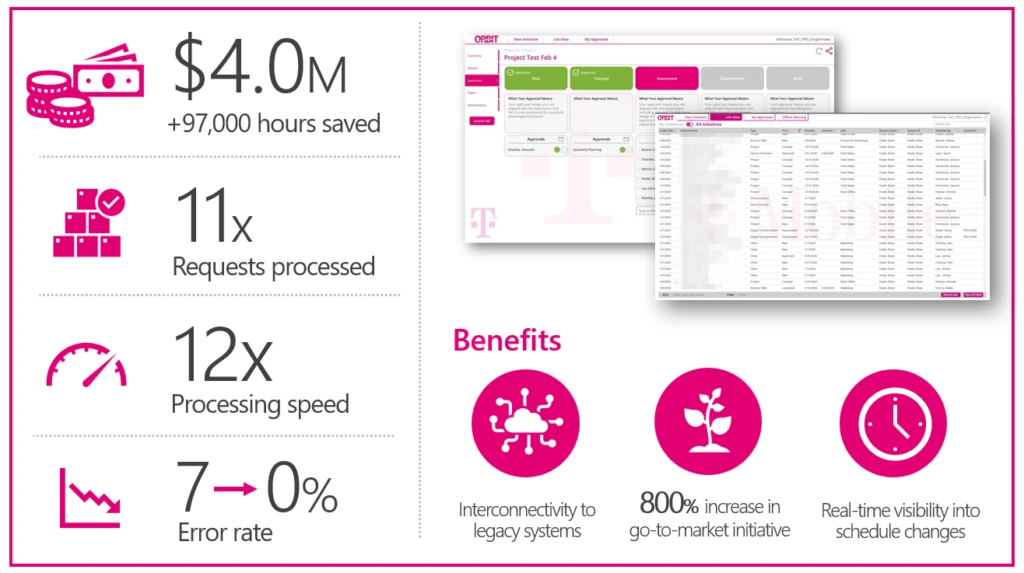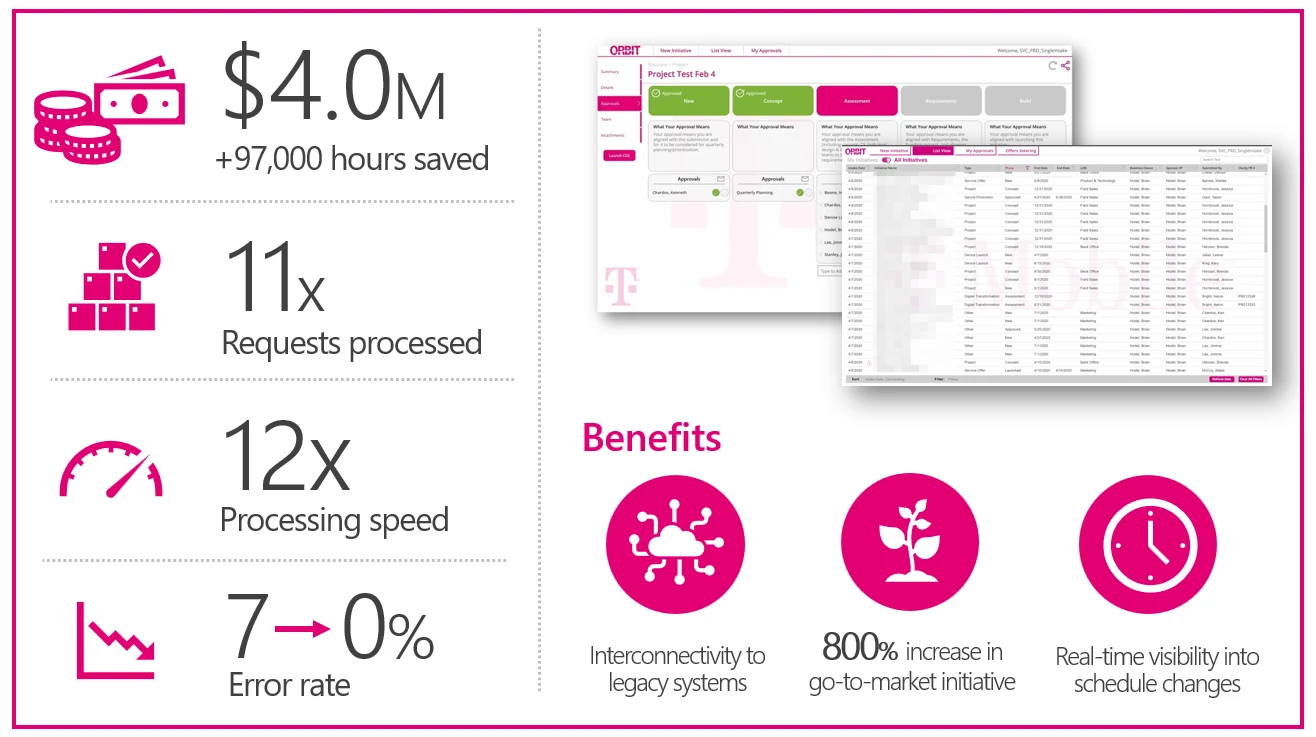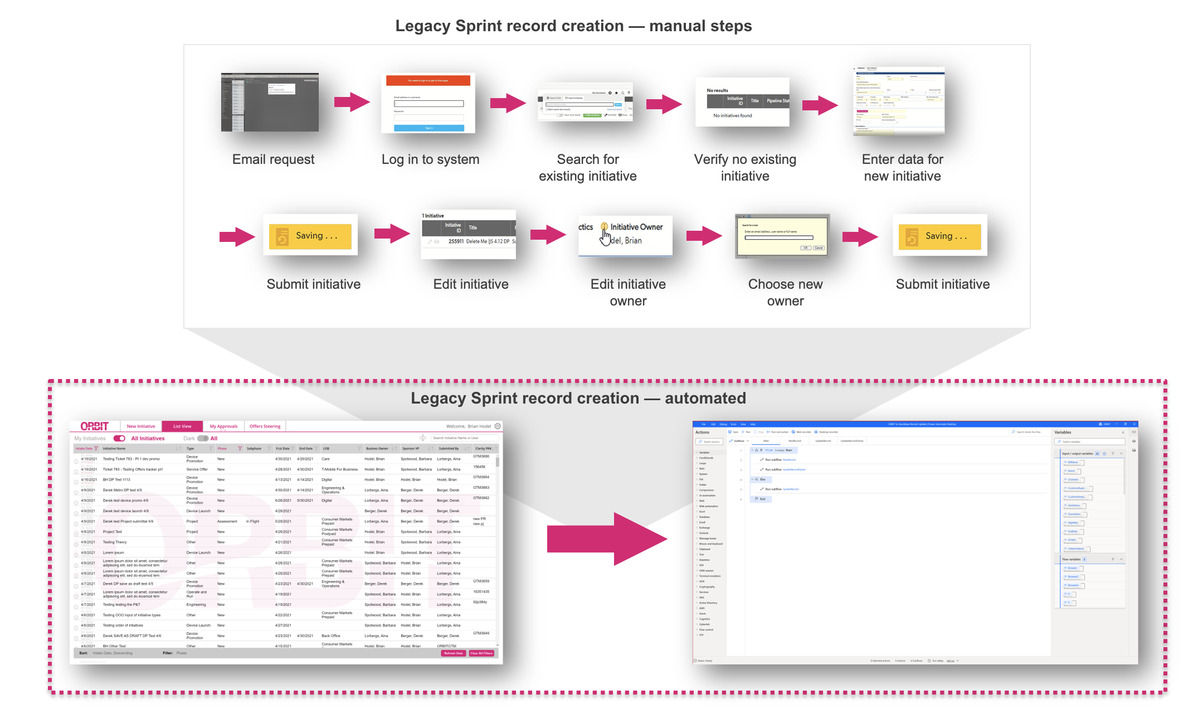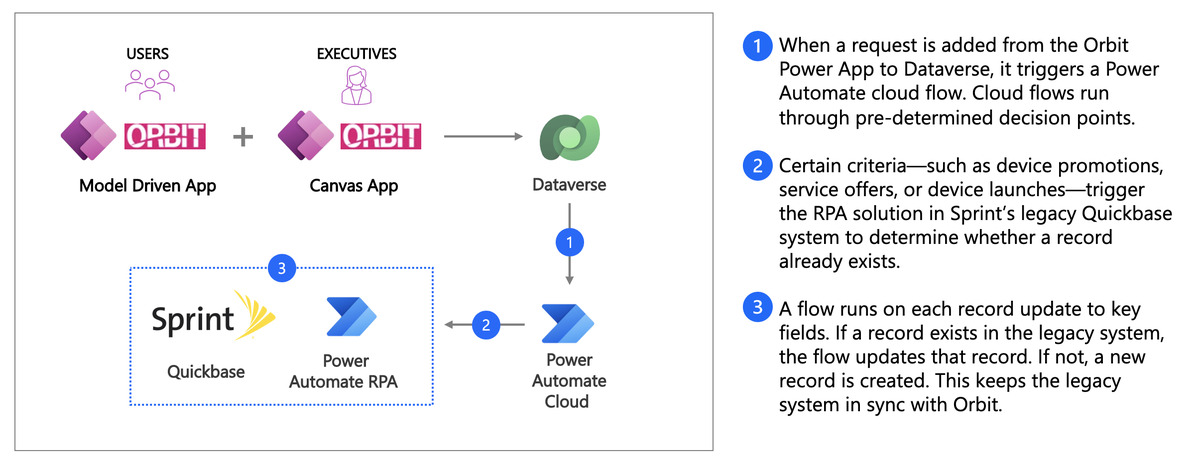
T-Mobile saves thousands of hours and achieves 12x gains in process efficiency with Power Platform
In this new blog series, we are sharing examples of customers who have been able to Do More With Less by utilizing Microsoft Power Platform in their organization to build applications, automate processes, determine insights and more. This week, we highlight how T-Mobile, one of the largest wireless carriers in the United States, has used Power Platform to save the company over $4M USD and 97,000 hours with a single Power Apps app – Orbit.
Orbit is used by team members, projects leads and executives to approve all new initiatives across the company, such as device promotions, service offers, and more. It uses Power Apps (canvas and model-driven apps), Power Automate, Power BI, Dataverse, and integrates with Microsoft Teams. In 2021, with the acquisition of Sprint, T-Mobile needed to integrate Orbit with Sprint’s legacy back-end systems. They turned to the robotic process automation (RPA) capabilities in Power Automate to help the two systems operate as one. As a result, they’ve been able to process 11x more requests in real time, improve the overall processing time by 12x and reduce errors from 7% to 0%.

Helping two companies operate as one
The Sprint side of the business was using Quickbase for detailed project management aspects such as tracking tasks and timelines. Post the merger, when companies began to integrate their business operations and IT systems, Hodel and his team started designing a way to integrate the Orbit app with Sprint’s legacy system. Building a complicated integration across two legacy IT systems was no small task. “At first, this was a very manual process,” says Hodel. “We would pull reports, see what’s changed, and then go in and either create or update the records of the legacy system. There were data-entry errors and a large time commitment. Unlike most processes that are repetitive, things ended up being batch-inserted. Eventually, updates were only happening once a week. There was a latency of the data, which is really challenging when you have to work on things that are moving as fast as they do in this world.”

To connect the two systems and eliminate some of the manual steps, Hodel and his team members first attempted to integrate into the APIs of Sprint’s legacy customer initiative and promotion system, Quickbase. There was no technical API documentation available, and the process became overwhelmingly complex. Hodel and his team started looking at other options. They had a long history of using Power Automate cloud flows, including within the existing Orbit app, so they decided to try the robotic process automation (RPA) capabilities within Power Automate for desktop. The UI-based approach in RPA turns manual tasks into automated workflows by recording and playing back human-driven interaction with software systems that don’t support API-based automation. “Within a very short period, we were able to get the RPA solution working without any training. Using the RPA capabilities in Power Automate was a very natural process”, Hodel says.
Before the Sprint merger, majority of the automation workflows within the Orbit app were built with Power Automate cloud flows. Now when specific criteria are met— device promotions, service offers, or device launches—these flows trigger the Power Automate RPA desktop flow within Sprint’s legacy Quickbase system. The flow either updates the existing record or creates a new record. This keeps the Orbit app and the legacy Sprint system in sync.

“In order for us to work across the organization in a real-time way, we need real-time data access, and the RPA scenario allows us to do that.”
-Brian Hodel: Principal Developer, Power Platform, T-Mobile
Saving time and improving efficiencies
The Orbit app, which has been running in production since February 2020 has been able to support a growth of 150% each year and a total 800% increase in go-to-market initiatives without needing to add additional resources, resulting in savings of $4M USD and 97,000 hours. The RPA capabilities in Power Automate solved the issues caused by the need for manual data input, greatly improving processing time and data accuracy, which freed up the analyst’s time to work on more strategic projects and increase job satisfaction.
Hodel advises other teams not to underestimate the power of a low-code solution.
“Don’t be fooled by the low-code branding. It is absolutely low code because anyone can quickly go in and learn the tools and move forward but it is fully capable of delivering on any sort of business requirements. Anything you can build with the full-code solution, you’re likely to be able to do with Power Platform as well. Really, consider it a no-limits platform.”
Read more about how T-Mobile continues to innovate with Power Platform to save money and realize process efficiencies with ease.
- T-Mobile adopts Microsoft Power Platform for fast and powerful low-code development
- T-Mobile uses RPA in Power Automate to integrate systems during Sprint merger
- Orbit app by T-Mobile to manage approval of customer initiatives
Find other “Do More With Less” stories
- Equinor embraces Power Platform to increase process efficiency while cutting costs
- Coca-Cola United automates over 50,000 orders in complex SAP invoicing process
- Leading US hospice care provider VITAS Healthcare processes 2 million patient visits to date
- Rabobank streamlines complex process from three weeks to three minutes
- Johnson Controls simplifies their infrastructure, saving 3,610 hours on training enablement
